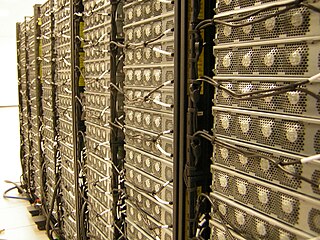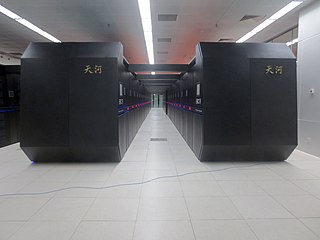
A supercomputer is a computer with a high level of performance compared to a general-purpose computer. The performance of a supercomputer is commonly measured in floating-point operations per second (FLOPS) instead of million instructions per second (MIPS). Since 2017, there are supercomputers which can perform up to nearly a hundred quadrillion FLOPS. Since November 2017, all of the world's fastest 500 supercomputers run Linux-based operating systems. Additional research is being conducted in China, the United States, the European Union, Taiwan and Japan to build even faster, more powerful and more technologically superior exascale supercomputers.

Blue Gene is an IBM project aimed at designing supercomputers that can reach operating speeds in the PFLOPS (petaFLOPS) range, with low power consumption.

System X was a supercomputer assembled by Virginia Tech's Advanced Research Computing facility in the summer of 2003. Costing US$5.2 million, it was originally composed of 1,100 Apple Power Mac G5 computers with dual 2.0 GHz processors. System X was decommissioned on May 21, 2012.
EPCC, formerly the Edinburgh Parallel Computing Centre, is a supercomputing centre based at the University of Edinburgh. Since its foundation in 1990, its stated mission has been to accelerate the effective exploitation of novel computing throughout industry, academia and commerce.
The Texas Advanced Computing Center (TACC) at the University of Texas at Austin, United States, is an advanced computing research center that provides comprehensive advanced computing resources and support services to researchers in Texas and across the USA. The mission of TACC is to enable discoveries that advance science and society through the application of advanced computing technologies. Specializing in high performance computing, scientific visualization, data analysis & storage systems, software, research & development and portal interfaces, TACC deploys and operates advanced computational infrastructure to enable computational research activities of faculty, staff, and students of UT Austin. TACC also provides consulting, technical documentation, and training to support researchers who use these resources. TACC staff members conduct research and development in applications and algorithms, computing systems design/architecture, and programming tools and environments.

The National Energy Research Scientific Computing Center, or NERSC, is a high performance computing (supercomputer) user facility operated by Lawrence Berkeley National Laboratory for the United States Department of Energy Office of Science. As the mission computing center for the Office of Science, NERSC houses high performance computing and data systems used by 7,000 scientists at national laboratories and universities around the country. NERSC's newest and largest supercomputer is Cori, which was ranked 5th on the TOP500 list of world's fastest supercomputers in November 2016. NERSC is located on the main Berkeley Lab campus in Berkeley, California.

The TOP500 project ranks and details the 500 most powerful non-distributed computer systems in the world. The project was started in 1993 and publishes an updated list of the supercomputers twice a year. The first of these updates always coincides with the International Supercomputing Conference in June, and the second is presented at the ACM/IEEE Supercomputing Conference in November. The project aims to provide a reliable basis for tracking and detecting trends in high-performance computing and bases rankings on HPL, a portable implementation of the high-performance LINPACK benchmark written in Fortran for distributed-memory computers.
PERCS is IBM's answer to DARPA's High Productivity Computing Systems (HPCS) initiative. The program resulted in commercial development and deployment of the Power 775, a supercomputer design with extremely high performance ratios in fabric and memory bandwidth, as well as very high performance density and power efficiency.

Jaguar or OLCF-2 was a petascale supercomputer built by Cray at Oak Ridge National Laboratory (ORNL) in Oak Ridge, Tennessee. The massively parallel Jaguar had a peak performance of just over 1,750 teraFLOPS. It had 224,256 x86-based AMD Opteron processor cores, and operated with a version of Linux called the Cray Linux Environment. Jaguar was a Cray XT5 system, a development from the Cray XT4 supercomputer.

SciNet is a consortium of the University of Toronto and affiliated Ontario hospitals. It has received funding from both the federal and provincial government, Faculties at the University of Toronto, and affiliated hospitals.
India's supercomputer program was started in late 1980s because Cray supercomputers were denied for import due to an arms embargo imposed on India, as it was a dual-use technology and could be used for developing s.

The K computer – named for the Japanese word "kei" (京), meaning 10 quadrillion (1016) – is a supercomputer manufactured by Fujitsu, currently installed at the Riken Advanced Institute for Computational Science campus in Kobe, Hyōgo Prefecture, Japan. The K computer is based on a distributed memory architecture with over 80,000 compute nodes. It is used for a variety of applications, including climate research, disaster prevention and medical research. The K computer's operating system is based on the Linux kernel, with additional drivers designed to make use of the computer's hardware.
Tsubame is a series of supercomputers that operates at the GSIC Center at the Tokyo Institute of Technology in Japan, designed by Satoshi Matsuoka.

Several centers for supercomputing exist across Europe, and distributed access to them is coordinated by European initiatives to facilitate high-performance computing. One such initiative, the HPC Europa project, fits within the Distributed European Infrastructure for Supercomputing Applications (DEISA), which was formed in 2002 as a consortium of eleven supercomputing centers from seven European countries. Operating within the CORDIS framework, HPC Europa aims to provide access to supercomputers across Europe.
FeiTeng is the name of several computer central processing units designed and produced in China for supercomputing applications. The microprocessors have been developed by Tianjin Phytium Technology. The processors have also been described as the YinHeFeiTeng family. This CPU family has been developed by a team directed by NUDT's Professor Xing Zuocheng.

The high performance supercomputing program started in mid-to-late 1980s in Pakistan. Supercomputing is a recent area of Computer science in which Pakistan has made progress, driven in part by the growth of the information technology age in the country. Developing on the ingenious supercomputer program started in 1980s when the deployment of the Cray supercomputers was initially denied.

Tianhe-2 or TH-2 is a 33.86-petaflop supercomputer located in National Supercomputer Center in Guangzhou, China. It was developed by a team of 1,300 scientists and engineers.

The Cray XC40 is a massively parallel multiprocessor supercomputer manufactured by Cray. It consists of Intel Haswell Xeon processors, with optional Nvidia Tesla or Intel Xeon Phi accelerators, connected together by Cray's proprietary "Aries" interconnect, stored in air-cooled or liquid-cooled cabinets. The XC series supercomputers are available with the Cray DataWarp applications I/O accelerator technology.

Fermi is a 2.097 petaFLOPS supercomputer located at CINECA.
















